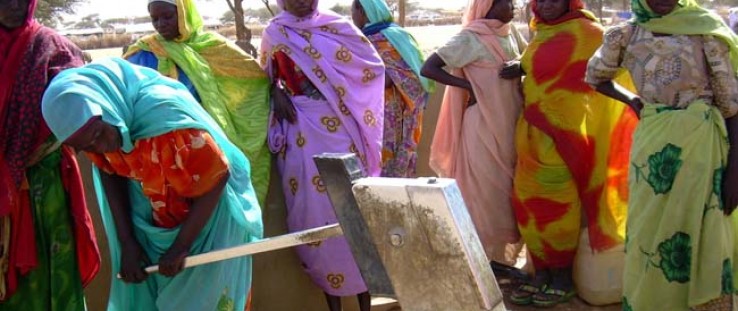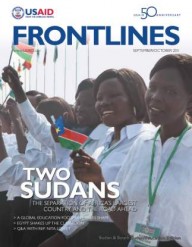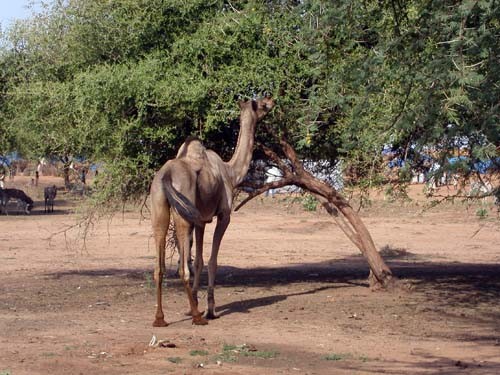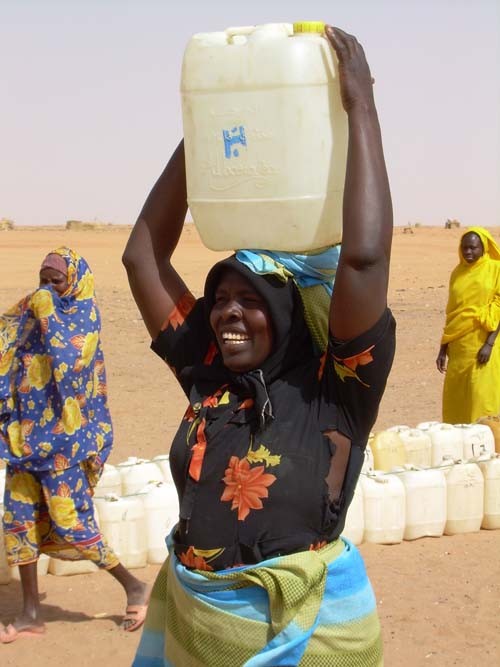 A woman uses a hand pump in a Kassab camp for internally displaced persons near Kutum.
Oumar M'Bareck , USAID
A woman uses a hand pump in a Kassab camp for internally displaced persons near Kutum.
Oumar M'Bareck , USAID
 A woman uses a hand pump in a Kassab camp for internally displaced persons near Kutum.
Oumar M'Bareck , USAID
A woman uses a hand pump in a Kassab camp for internally displaced persons near Kutum.
Oumar M'Bareck , USAID
Since conflict erupted in Darfur in 2003, between 1.9 million and 2.7 million people have been forced to flee their homes. Now, in some areas, many are returning home.
Individuals displaced from Nyoro, West Darfur, began voluntarily returning in early 2011. To assist their reintegration into their communities, USAID, since early April, has supported returnees with building materials for shelters and household latrines, while educating the community about proper hygiene.
The Agency is also supporting training for returnees to acquire skills such as masonry—providing valuable expertise that can be used immediately in rebuilding the war-torn region.
“Life as a displaced person is difficult, we brought nothing,” said one mother of five children. “We were forced to depend on others for food and other necessities for survival. Now we have returned back to our village, Nyoro, and everything has been destroyed.” USAID’s partner organization, she explained, “has been here to help us rebuild our shelters and help us build our own latrines.”
As a leading donor, USAID has provided more than $2.7 billion in emergency food and other lifesaving assistance in Darfur since the conflict began in 2003. And although insecurity and violence continue in parts of Sudan’s vast western region, relative stability in others has allowed the Agency to expand support to community-led, early-recovery programs. Defined as the stage between humanitarian relief and long-term recovery, early-recovery activities—in agriculture and food security; shelter; economic recovery; and water, sanitation, and hygiene—help Darfuris rebuild livelihoods by giving them the tools they need to increase their economic independence.
“Armed clashes, generalized insecurity, and bureaucratic impediments continue to restrict access to parts of Darfur,” said Tahir Ali, USAID’s senior humanitarian adviser in Sudan. “But there are other areas, including in and around the major urban centers, where the great majority of internally displaced persons are located, that are stable, secure, and accessible for humanitarian and development workers. We can make a real difference by seizing opportunities in these parts of Darfur to assist people to re-establish productive and self-sufficient lives, helping them recover from the negative impacts of conflict, and avoid dependency on relief aid.”
Seeds, Troughs, and Computers
To improve food security while supporting the development of a local seed market, USAID partners have moved from direct distribution of seeds to the promotion of seed fairs, where farmers use vouchers to buy from local vendors. This allows them to obtain seeds for planting while supporting the local economy.
Through humanitarian partners, the Agency stimulates markets by rehabilitating critical transport roads and providing support to micro-entrepreneurs. This includes vocational training in computer and mechanic skills that are in high demand in the area.
To increase the resiliency of Darfuri livestock owners and improve the health of their herds, USAID partners train community animal-health workers and help them build water troughs for animals.
USAID is exploring a variety of ways to support water projects in Darfur. At the United Nations-sponsored Darfur International Conference on Water for Sustainable Peace in Khartoum in late June, Ambassador Dane Smith, the U.S. senior adviser for Darfur, announced that USAID intends to contribute a further $2 million for water projects in the region on top of approximately $14.9 million in fiscal year 2011 funding for programs supporting improved access to clean water.
While water has been a significant source of conflict and contributes to population movement in Darfur, experts stress that the problem is not a lack of water, but rather that water is often not where people need it. Conflict displaced much of Darfur’s rural population, shifting thousands of people to towns where water demand is now concentrated, but where there is too little water for the people’s basic needs.
USAID has helped construct hand-dug wells as water sources for household and livestock use, hafirs (reservoirs) for agricultural use, and sub-surface dams where access to safe drinking water through boreholes or hand-dug wells is limited. USAID is also rehabilitating water yards—organized, fenced locations with boreholes, pumps, tanks, taps, and troughs—providing individuals and livestock access to safe water.
Communities are taught how to harvest rainwater, and how to repair, rehabilitate, and maintain boreholes, hand-dug wells, and hand pumps. Other partners have connected urban water systems to outlying rural areas in need of a regular source of clean water.
Nurturing the Roots of Industry
USAID is also exploring possibilities for boosting the gum arabic industry in Darfur. Gum arabic, the dried sap of the Acacia senegal tree, is used in pharmaceutical, industrial, and food products, including soft drinks and confections. It keeps sugar uniformly suspended in carbonated drinks, binds newspaper ink to paper, and is used as a coating on medications.
On June 26 in Khartoum, USAID, the World Bank, and South Darfur’s Ministry of Agriculture and Forests held a workshop to discuss a new report financed by USAID and the World Bank, which concludes that medium-sized farms in South Darfur that produce gum arabic, annual crops, and livestock can be financially and environmentally sustainable family enterprises. The report derived from a request by the governor of South Darfur, who was seeking ways to rehabilitate the gum arabic production in his jurisdiction—the center of the Darfur region’s gum arabic industry.
It is initiatives like this that comprise a new USAID focus on community-led, early-recovery programs and activities for the region, where pockets of stability, and hence, opportunity, have begun to appear. They come eight years after war between armed opposition groups and Sudanese government forces and allied militia created a humanitarian crisis affecting more than 4.7 million people.
“While USAID remains committed to providing basic services and goods to Darfuris tragically affected by fighting and conflict, we are also actively pursuing the growing windows of opportunity to help jumpstart livelihoods and invigorate markets, where security conditions and the capacity of humanitarian partners to support community efforts are strong,” said Christa Capozzola, USAID deputy assistant administrator in the Bureau for Democracy, Conflict, and Humanitarian Assistance. “We want to focus these efforts to help the people of Darfur to lay the foundation for sustainable peace and development.”











Comment
Make a general inquiry or suggest an improvement.